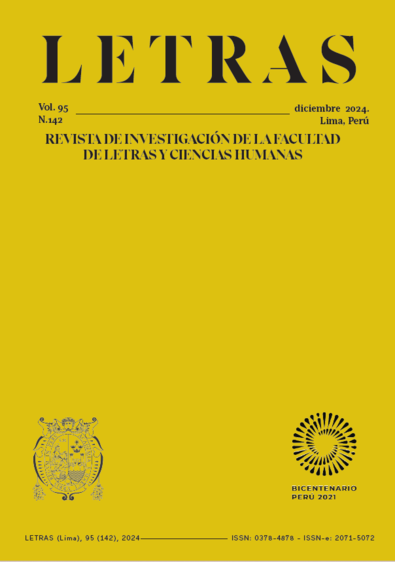Works of Art, Ekphrasis and Scopic Regimes in El siglo de las luces (1962) by Alejo Carpentier
Abstract
Critical studies on the relevance of the visual arts in El siglo de las luces (1962) by Alejo Carpentier have concentrated mainly on the emblematic character of painting in the narrative structure. This article recovers these readings in an allegorical and symbolic key to investigate other aspects that problematise the links between literature, scopic regimes and political praxis. Within this framework, we analyse the ekphrasis of the works of art present in El siglo de las luces as a device that combines a critical vision, not only the grounds of Enlightenment Modernity and their impact on Latin America, but also of the concept of modern art formulated in Europe during the eighteenth century. The study of ekphrasis exposes the questioning of two principles that define the category of modern European art: the principle of the autonomy of the work of art and that of the progress of artistic forms in tune with a linear and evolutionary model of temporality. Furthermore, the work explores the conception of art as an agent of transformation in scopic episteme (Brea, 2007) and the articulation between art and political praxis in the context of the Latin American neo-avant-gardes of the 1960s. Finally, the affiliations with the scopic regimes of the baroque and the artistic avant-gardes lead us to a reading of the imaginary transposition of the work of art in the denouement of the novel, whose transformation process goes from unstable baroque figuration to abstract disfigurement, imprinting a dialogue with post-war informalist artistic practices.Downloads
Métricas alternativas
References
Brea, J. L. (2007). Cambio de régimen escópico del inconsciente óptico a la e-image. En Estudios visuales: Ensayo, teoría y crítica de la cultura visual y el arte contemporáneo, 4, 145-163. http://www.fadu.edu.uy/estetica-diseno-ii/files/2019/03/cambio-de-r%C3%A9gimen-esc%C3%B3pico-completo.pdf
Brea, J. L. (2010). Visiones de un ojo técnico. Las tres eras de la imagen. Akal.
Breton, A. (2019 [1957]). El arte mágico. Atalanta.
Carpentier, A. (1985a [1962]). El siglo de las luces. (Edición de A. Fornet). Cátedra.
Carpentier, A. (1985b). Palabras en el tiempo de Alejo Carpentier (Entrevistas con Ramón Chao). Arte y Literatura.
Carpentier, A. (1985c). Entrevistas. (Edición de V. López Lemus). Letras Cubanas.
Carpentier, A. (1985d [1953]). Los pasos perdidos. Cátedra.
Carpentier, A. (1993). Letra y solfa. Artes visuales 3. Letras Cubanas.
Carpentier, A. (1987). Tientos, diferencias y otros ensayos. Plaza & Janés.
Carpentier, A. (2013). Diario (1951-1957). Letras Cubanas.
Castillo, A. (2020). Adicta imagen. La Cebra.
Didi-Huberman, G. (2018 [2000]). Ante el tiempo. Historia del arte y anacronismo de las imágenes. Adriana Hidalgo.
Escobar, T. (2021). Aura latente. Estética. Ética. Política. Técnica. Tinta Limón.
Franco, J. (1977). Modernización, resistencia y revolución. La producción literaria de los años sesenta. Escritura, 3(3), 3-19.
Gabrieloni, A. L. (2008). Écfrasis. Eadem Utraque Europa, 6, 83-108.
González Echevarría, R. (2004). Alejo Carpentier: el peregrino en su patria. Gredos.
Heffernan, J. A. (1993). Museum of Words. The Poetics of Ekphrasis from Homer to Ashbery. University of Chicago Press.
Jay, M. (2007). Ojos abatidos. La denigración de la visión en el pensamiento francés del siglo XX. Akal.
Lévi, E. (2017). El Zohar. Libro de los Esplendores. Biblok.
Mitchell, W. J. T. (2017). ¿Qué quieren las imágenes? Sans Soleil.
Mimoso-Ruiz, D. (1983). Du référent iconique à la symbolique des personnages. En D. Henri-Pageaux (Ed.), Quinze études autour de El siglo de las luces de Alejo Carpentier (pp. 165-186). L’Harmattan.
Ortega, J. (1972). Sobre El siglo de las luces. En K. Müller-Bergh (Ed.), Asedios a Carpentier. Once ensayos críticos sobre el novelista cubano (pp. 191-206). Editorial Universitaria.
Ortega, J. (1991). Discurso crítico y formación nacional. Revista de Crítica Literaria Latinoamericana, 17(33), 95-102. https://doi.org/10.2307/4530530
Parkinson Zamora, L. (2011). Barroco novomundista y la dinámica del espacio. En La mirada exuberante. Barroco novomundista y literatura latinoamericana (pp. 137- 199), Iberoamericana, Vervuert, Universidad Nacional Autónoma de México.
Rancière, J. (2005). Sobre políticas estéticas. Museo de Arte Contemporáneo.
Rancière, J. (2009). El reparto de lo sensible. Estética y política. LOM Ediciones.
Starobinski, J. (1988). 1789, los emblemas de la razón. Taurus.
Toledo, C. (2017). Literatura y artes visuales en tres escritores cubanos: Carpentier, Lezama Lima y Sarduy. Boletín de arte, 17, 54-58. http://papelcosido.fba.unlp.edu.ar/ojs/index.php/boa/article/view/489/77
Wakefield, S. (2004). Preposterous History and Impossible Revolution in El siglo de las luces. En Carpentier’s Baroque fiction: returning Medusa’s gaze (pp. 129-170). Tamesis.
Wall, C. E. (1988). The Visual Dimension of El siglo de las luces: Goya and Explosión en una catedral. Revista Canadiense de Estudios Hispánicos, 13(1), 148-157.
Copyright (c) 2024 Letras (Lima)

This work is licensed under a Creative Commons Attribution 4.0 International License.
Este obra está bajo una licencia de Creative Commons Reconocimiento 4.0 Internacional



















